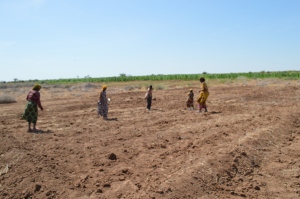By Mohamed Wako – Isiolo.
A community project that spearheads the community to earn a living without dependence on relief food, has changed way of life for communities living in Isiolo. The champions of these campaign are youth, who have come together as an advocacy group to teach the community on the history and culture of the community.

Community in a farm – Isiolo
Community Campaign Against Free Food (CCAFF), has members who are engaged in small scale farming during rainy seasons, after which they harvest subsistence crops like maize, tomatoes, and vegetables.
The group chairman explained to me about how the group has delved into the historical root causes of poverty in Isiolo county since independence. “The attempt by the larger Northern Kenya, that culminated into the Kenya government flexing its military muscle, committing atrocities on the community – resulting in huge losses of lives, wealth, pride, in what is commonly remembered as DABA( concentration camps) in Garba tula, Merti and Modo gashe for 14 months.
After they were freed from concentration camps , almost 90% of the population were destined for destitution, missionaries started coming to the aid of the young children, who were malnourished, most of them orphans and others separated from parents by the shifta war, they provided porridge and warm clothes, immediately established missionary centres at Garba tula and Merti to take care of the orphaned and needy children. The adult population were left alone to grapple with hardships of the aftermath of the shifta war.”
Early 1974 the government set up irrigation schemes under foreign donor support at Rapsu, Malka daka and Gafarsa, which did the best in reviving the lives of these community. Donors provided the necessary technical support by providing tractors, vehicles, farm implements, seedlings and extension officers to advice. The scheme produced among other crops cotton, pepper, maize, beans, onions, tomatoes, potatoes, groundnuts, vegetables and fruits to commercial scale, the marketing was done by the managers of the project who were by then foreigners, cotton was sold to rift valley textiles in nakuru. The community claim the herds of animals that remained after the shifta war perished during the 1976 drought and the livestock these community acquired later were bought by money made from sells of produce harvested at scheme. The scheme collapsed in 1978 after the moi took the reigns of leadership, the donor support ended or terminated and the managers who took over to run the project, looted and killed the project a natural death.
Equipped with these facts, these group mobilizises other like minded individuals as a caucus agitating for and hoping to influence county government policies on value addition of pastoralists products , hence showing the way on sedentary farming as a way to chat and bring to an end the era of relief food dependence.
“We are working with other groups to present our ideas for adaptation to county government, on matters of value addition on pastoralists products and farming by irrigation, as the bright idea of adopting to w climate change phenomenon is very evident.” Said Mr. Hassan Demo a member of CCAFF .He further added that, the group are not only suggesting but are contributing to a way forward by identifying the ideal land fertile for farming, considering the proximity to water sources and seasonal streams which can be arrested during rainy seasons to be useful for irrigation during dry spells. They further suggest that, the county government would realize better food security initiatives and success projects on the same.
“We are going to press upon the county government about improving on irrigation farming , to be one of their their mega projects, we have identified potential areas very ideal for farming and they will not regret injecting just a half of their revenue budgeted for relief food.” Added Mr. Demo.
“It may be a dream for some, but for us , it’s a dream come true,” he concludes.
